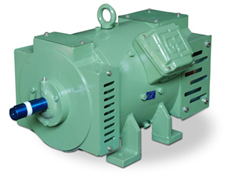| |
 |
|
GE MOTORS (PVT.) LTD" make DC Motors are available with different Performance Characteristics and accordingly are classified into SHUNT / SERIES & COMPOUND Motors.DC motors have definite applications in today's industry. Each type offers specific characteristics and strengths, depending on the task at hand.
Shunt wound Motors are the most widely used as they have a linear characteristic of Voltage & Torque. Shunt motor has more constant and controllable speed over various loads.
DC motors have definite applications in today's industry. Each type offers specific characteristics and strengths, depending on the task at hand.
|
|
| |
Shunt wound Motors are the most widely used as they have a linear characteristic of Voltage & Torque. Shunt motor has more constant and controllable speed over various loads.
Series Wound Motors are used for High starting Torque Applications. Series motor has greater torque capabilities. This type of motor speed varies automatically with the load, increasing as the load decreases. Use of series motor is generally limited to case where a heavy power demand is necessary to bring the machine up to speed, as in the case of certain elevator and hoist installations, for steelcars, etc. Series-wound motors should never be used where the motor cab be started without load, since they will race to a dangerous degree.
Common uses of the series motor include crane hoists, where large heavy loads will be raised and lowered and bridge and trolley drives on large overhead cranes. The series motor provides the starting torque required for moving large loads. Traction motors used to drive trains are series motors that provide the required torque and horsepower to get massive amounts of weight moving.
Compound Wound Motors are used for Mixed Load Applications. The above two desirable characteristics can be found in the same motor by placing both a Series field and Shunt field winding on the same pole. Thus we have, the Compound motor. The Compound motor responds better to heavy load changes than a Shunt motor because of the increased current through the series field coils. This boosts the field strength, providing added torque and speed.
A combination of the shunt wound and series wound types combines the characteristics of both. Characteristics may be varied by varying the combination of the two windings. These motors are generally used where severe starting conditions are met and constant speed is required at the same time When comparing the advantages of the series and shunt motors, the series motor has greater torque capabilities while the shunt motor has more constant and controllable speed over various loads. These two desirable characteristics can be found in the same motor by placing both a series field and shunt field winding on the same pole. Thus, we have the compound motor.
The compound motor responds better to heavy load changes than a shunt motor because of the increased current through the series field coils. This boosts the field strength, providing added torque and speeds.
If a shunt coil is added to a series motor at light loads (when a series motor tends to over speed) the added shunt field flux limits the top speed, eliminating self-destruction.
Common uses of the compound motor include elevators, air compressors, conveyors, presses and shears. Compound motors can be operated as shunt motors by disconnecting the series field. Many manufacturing process lines are designed this way. The reason being that, most off the shelf motors are compound motors, and the series field can always be connected later to provide additional torque, if needed. |
|